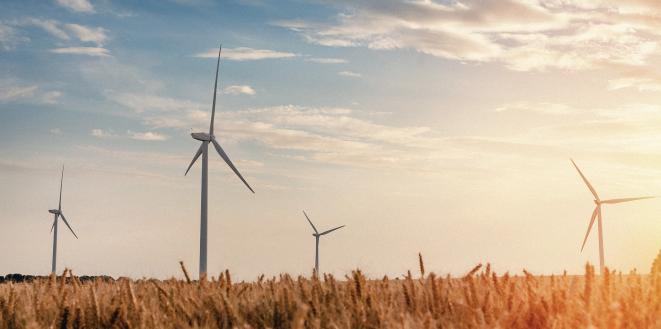How is electricity generated using wind?
Wind is all around us. It’s clean, it’s free (at point of generation) and is a reliable source of energy for countries all around the world. Every day, wind turbines capture the wind’s power and convert it into electricity.
It’s a fairly simple process: When the wind blows the turbine's blades spin, capturing energy – this energy is then sent through a gearbox to a generator, which converts it into electricity for the grid with a special device called an inverter.

There’s never been a more exciting time to work in energy.
We have around 23 gigawatts of wind-powered electricity capacity on the grid – several times that of nuclear. And in 2020 around 25% of Britain’s electricity was generated by wind, second only to gas in the sources that power our grid.
The UK’s geographical position means wind provides a fairly reliable source of energy. But we need turbines, and lots of them, to turn it into useful energy.
“There’s a perception that turbines are huge structures standing still at the side of the road not doing much,” says James. “But the stats show a different story. Just one turbine can make the electricity to power 16,000 homes a year. When you think we have multiple wind farms all around the UK, you can see that adds up to an awful lot of power.”
The UK government plans to invest £160m in offshore wind power to ensure the UK produces enough electricity to power every home in the country by 2030.
The latest turbines are super-efficient too. Unlike the older turbines (the first ones date back to the 1980s), they can operate well whatever the weather, and last for decades. Turbines are also much more flexible than say, a nuclear reactor (which currently operates to supply part of the base load), as you don’t have to have the entire wind farm running and can even feather the individual turbines to optimise their outputs.
The latest windfarm being built in the UK, Dogger Bank, will be the biggest yet. More than 80 miles from land, it will house around 200 of the world’s most powerful wind turbines, each almost as tall as The Shard, and populate an expanse of sea as large as North Yorkshire. Some of the newest turbines can power a home for a day with just one rotation of its blades.
Investments such as this help our progress in decarbonising British electricity. Learn more about carbon intensity and download our app.
But as with most things, there are downsides too.
“The UK is never going to be at a position where it’s 100% dependent on wind energy alone, it’s always a cocktail.” says James. “On the rare occasions when there’s no wind, we still need power. Demand is typically highest in the South East of England so you need to figure out how to distribute the energy from our wind farms, which are typically in windy places, like the North Sea." The Western Link subsea power cable which carries power from Scotland to England, is one way of allowing the flow of more clean energy south.
“Predicting can also be a challenge as we do that based on the weather, so there’s always an element of forecast uncertainty. But we use machine learning techniques and statistical modelling for this backed up with ancillary services and extensive planning. Therefore, we can top up the rest irrespective of how sunny it is or how windy.”
While we expect zero carbon sources like wind to dominate electricity supplies in the future, we also expect to have a diverse generation mix – including wind, solar, storage, nuclear and interconnectors.
“The key thing with electricity is it's made up like a cocktail mixture of all different types of ingredients and we combine these different flavours to produce a balanced grid second by second,” added James. “Just like changing your diet to be healthier, the grid’s fuels are changing to be greener, with carbon emitting fuels on the decline being replaced with zero carbon solutions to allow us to reach net zero.
There has never been a more exciting time to work in energy.”
